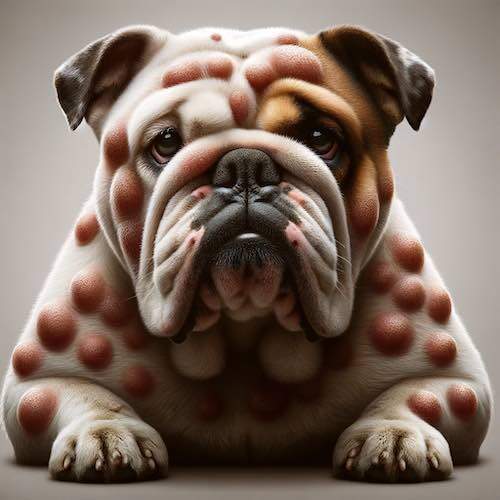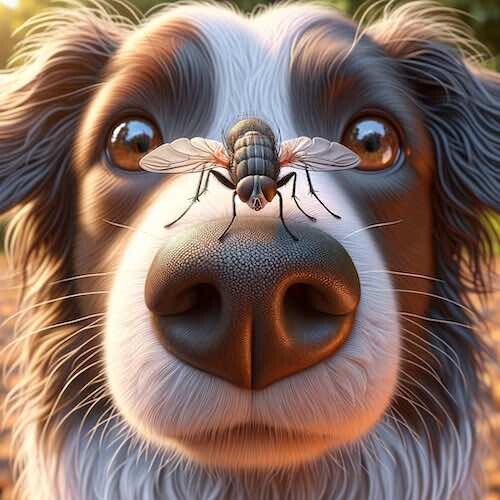Dog Hives: An Overview of Causes, Symptoms, and Treatment
Dog hives, or urticaria, represent a prevalent dermatological issue impacting canines across a wide spectrum of breeds and life stages. This condition manifests through the abrupt emergence of circular, elevated lesions on the skin, which are frequently marked by an intense itchiness that can lead to considerable unease and distress in affected animals. Beyond the physical symptoms, hives can also signal underlying health concerns or allergic reactions that require attention.
Through a comprehensive exploration of the factors leading to hives, their common manifestations, and the various treatment avenues available, this article aims to equip pet owners with a thorough understanding of how to manage this condition. Addressing hives promptly and effectively not only alleviates immediate discomfort but also plays a crucial role in maintaining the overall health and well-being of our canine companions, ensuring they lead a happy and comfortable life.
Causes of Dog Hives
Food Allergies
Food allergies stand as a significant factor behind allergic reactions in dogs, including the occurrence of hives. Similar to humans, dogs can exhibit adverse reactions to certain components in their diet, with protein sources such as beef, chicken, dairy products, soy, and wheat commonly identified as triggers. Intriguingly, a dog might develop an allergy to a particular food ingredient even after years of consuming it without any apparent problems, underscoring the unpredictable nature of food allergies.
The process of pinpointing the exact ingredient causing the allergic reaction is critical in addressing and managing the issue effectively. This often involves implementing an elimination diet, where potential allergens are systematically removed from the dog’s diet to observe any improvement in symptoms. Once the allergenic ingredient is identified, it can be permanently excluded from the dog’s meals, thereby alleviating the allergic response.
Moreover, transitioning to hypoallergenic dog food formulations designed to minimize the risk of allergic reactions can be beneficial. These specially formulated diets use protein sources that are less likely to trigger allergies, such as venison or duck, and are often recommended by veterinarians for dogs with food sensitivities.
Understanding and managing food allergies in dogs requires a proactive and informed approach, involving careful observation, dietary adjustments, and possibly veterinary intervention. By identifying and eliminating the offending food, dog owners can significantly improve their pet’s quality of life, reducing the frequency and severity of allergic reactions such as hives. This not only contributes to the dog’s overall well-being but also fosters a happier, more comfortable living environment for both the pet and its owners.
Environmental Allergens
The external environment harbors an array of allergens capable of triggering allergic reactions in dogs, with pollen from trees, grasses, and weeds, mold spores, and dust mites being among the most common culprits. These allergens tend to become more prevalent and problematic during specific seasons, notably spring and fall, when their levels surge, increasing the risk of hives and other allergic responses in susceptible dogs. Strategies such as keeping pets indoors on days when pollen counts are exceptionally high can significantly reduce exposure.
Additionally, implementing regular cleaning routines within the home, including the use of air purifiers and frequent vacuuming, can further help in minimizing the presence of these environmental triggers. By adopting such preventive measures, dog owners can protect their pets from the discomfort and health issues associated with allergic reactions, ensuring their furry companions remain happy and healthy throughout the year, regardless of the season’s allergen levels.
Insect Bites and Stings
An encounter with a bee, spider, or flea can be more than just painful for a dog; it can also trigger an allergic reaction leading to hives. The reaction is typically localized to the area around the bite or sting but can spread, causing discomfort and distress. Preventative measures against fleas and ticks and vigilance during outdoor activities can reduce the risk of such encounters.
Chemical Exposures
The myriad chemicals present in everyday products, ranging from household cleaners to lawn treatments and personal care items such as shampoos, pose a risk of eliciting allergic reactions in dogs. The array of substances dogs come into contact with is vast and varied, potentially leading to sensitivities that manifest as hives. Moreover, while certain medications and vaccines play a pivotal role in maintaining a dog’s health, they too can sometimes trigger allergic responses.
To navigate this landscape safely, opting for natural, pet-safe alternatives whenever possible is advisable. Such choices can significantly reduce the likelihood of allergic reactions. Furthermore, initiating a conversation with your veterinarian about any concerns regarding potential allergies before introducing new medications or vaccines is crucial. This proactive approach ensures that any risks are carefully weighed against the benefits, fostering a safer and more comfortable environment for your pet. By making informed choices about the products and treatments your dog is exposed to, you can help minimize their exposure to potential allergens and safeguard their well-being.
Direct Contact
Certain dogs might experience hives due to direct exposure to specific materials. This can include fabrics that have undergone chemical treatments, as well as items made from rubber or plastic, which could potentially irritate a dog’s skin, especially if the dog has a predisposition to sensitivities. It’s crucial for pet owners to be vigilant about the types of materials their pets interact with daily. Opting for hypoallergenic bedding, toys, and even clothing can significantly reduce the risk of such allergic reactions.
Additionally, avoiding products with harsh dyes, perfumes, or chemical coatings can further protect your dog from unwanted skin irritation. Investing in natural, organic pet care items and regularly checking the composition of your dog’s environment for potential allergens are proactive steps towards safeguarding your pet’s health and preventing the discomfort associated with hives. This careful selection of pet-friendly products not only contributes to a safer environment for your dog but also promotes overall well-being by minimizing exposure to irritants that could trigger allergic reactions.
Price: $29.97 ($29.97 / Ounce)
1 used & new available from $29.97 ($29.97 / Ounce)
Symptoms of Dog Hives
The symptoms of hives in dogs, while relatively straightforward, offer a glimpse into the discomfort and potential distress these allergic reactions can cause. Understanding these symptoms in greater detail can empower pet owners to act swiftly, ensuring their canine companions receive the necessary care to alleviate discomfort and prevent complications.
Raised Bumps
The hallmark of hives, raised welts or bumps on the skin, can present a distressing sight for any pet owner. These bumps are typically round and can emerge on any part of the dog’s body, though they often concentrate in areas with thinner fur coverage. The size of these welts can vary, with some remaining small and others growing larger, depending on the severity of the allergic reaction. The welts are fluid-filled, which accounts for their raised appearance, and they may join together as they spread, covering larger areas of the body.
Itching
Itching, or pruritus, is a common and noticeable symptom of hives, driving dogs to scratch, lick, or bite at their skin in an attempt to relieve the irritation. This behavior not only exacerbates the skin’s condition but can also lead to the development of secondary skin infections. Dogs may become increasingly agitated as they struggle to soothe the relentless itchiness, making early intervention crucial to prevent further skin damage.
Swelling
Swelling, particularly around the face, eyes, lips, and ears, is another symptom that can accompany hives. This swelling, known as angioedema, can significantly affect a dog’s appearance and, in severe cases, may lead to respiratory distress if the throat and airways become involved. Immediate veterinary attention is required in such instances to prevent life-threatening complications.
Redness and Inflammation
The skin surrounding the hives often appears red and inflamed, a direct result of the body’s allergic response. This redness can spread beyond the immediate area of the welts, indicating widespread inflammation. The affected skin may feel warmer to the touch and can be a source of significant discomfort for the dog.
Behavioral Changes
Dogs experiencing the discomfort of hives may exhibit noticeable changes in behavior. Restlessness, excessive grooming behaviors such as licking and biting at the skin, and avoidance of touch or interaction can all be signs that a dog is in distress. These behavioral changes, while subtle at times, are indicative of the underlying discomfort caused by hives and should prompt a consultation with a veterinarian.
Recognizing the symptoms of hives in dogs is the first step toward alleviating their discomfort and addressing the underlying cause of the allergic reaction. Pet owners should regularly inspect their dog’s skin, particularly if they notice any behavioral changes suggestive of discomfort or distress. Early detection of hives, followed by prompt veterinary care, can significantly improve the prognosis, ensuring quick relief from symptoms and reducing the risk of complications such as secondary infections.
Treatment of Dog Hives
Treating dog hives effectively requires a multifaceted approach that combines immediate interventions to relieve discomfort with strategies aimed at preventing future episodes. This comprehensive treatment plan ensures both the short-term wellbeing and long-term health of your canine companion. Here’s a detailed look at the treatment options and preventive measures for managing dog hives:
Search: Best Allergy Treatment Relief For Dog
Antihistamines
Antihistamines play a pivotal role in the quick mitigation of allergic reactions, helping to ease the itching and discomfort associated with hives. These medications work by blocking the effects of histamine, a chemical released during an allergic reaction. Veterinarians frequently prescribe antihistamines as a first line of defense against hives. However, it’s imperative to consult with a vet prior to administering these drugs to determine the appropriate type and dosage for your dog, as individual needs can vary significantly.
Price: $5.50
3 used & new available from $5.50
Corticosteroids
In more severe cases, where the allergic reaction is intense and the dog is in considerable distress, corticosteroids may be prescribed. These powerful anti-inflammatory drugs can rapidly reduce swelling and alleviate itching. While corticosteroids are highly effective, they are typically recommended for short-term use due to the potential for side effects with prolonged administration. Your veterinarian will guide the usage of these medications, ensuring they are used safely and effectively.
Identifying and Managing Allergens
A critical component of treating hives is identifying the underlying allergen responsible for triggering the reaction. This may involve a detailed evaluation of the dog’s environment, diet, and recent exposures. Once the allergen is identified, measures should be taken to reduce or eliminate your dog’s contact with it. This could entail dietary adjustments, changes in household cleaning products, or modifications to the dog’s outdoor activities. Avoidance is often the most effective strategy in preventing hives from recurring.
Cool Baths
Administering a cool bath can provide immediate soothing relief for a dog suffering from hives. Oatmeal baths or hypoallergenic shampoos are particularly beneficial, as they can calm inflamed skin without causing further irritation. This simple yet effective remedy can make a significant difference in your dog’s comfort level during an allergic episode.
Monitoring and Emergency Situations
In situations where hives lead to swelling in the throat or difficulty breathing, immediate veterinary attention is required. Such reactions can escalate quickly and may become life-threatening. Pet owners should closely monitor their dogs following an outbreak of hives for any signs of respiratory distress or other severe symptoms, ensuring prompt action is taken when necessary.
Long-term Preventive Measures
Implementing a consistent grooming routine, coupled with the utilization of hypoallergenic pet care products, plays a pivotal role in mitigating the likelihood of recurrent hives outbreaks in dogs. The choice of grooming products is crucial; opting for shampoos and conditioners specifically formulated for sensitive skin can help maintain the skin’s natural barrier, preventing irritation that could lead to hives. Moreover, the environment in which a dog resides significantly influences its exposure to allergens. Regularly cleaning the home, using air purifiers to reduce airborne allergens, and ensuring bedding and play areas are kept free from dust and pollen are essential steps in creating a safe haven for your pet.
Routine veterinary check-ups serve as an additional safeguard, allowing for early detection and intervention of potential health issues. Engaging in open discussions with your vet about your dog’s diet, lifestyle, and any changes in their environment or behavior can provide valuable insights into managing and preventing hives.
Embracing a holistic strategy that encompasses both treatment and prevention empowers dog owners to effectively tackle hives. This includes being vigilant about immediate care, diligently managing potential allergens, and implementing strategies aimed at bolstering the dog’s overall health. Such an approach underscores the significance of proactive care, ensuring dogs not only recover from episodes of hives but also enjoy a higher quality of life, free from the discomfort and distress associated with allergic reactions. Through informed and attentive care, pet owners can significantly enhance their dogs’ comfort and happiness, reinforcing the bond between them and their cherished canine companions.
Read More: Top 10 Best Grain-Free Dog Food Brands
Conclusion
The occurrence of hives in dogs, although potentially distressing, is a condition that can be effectively managed with informed care and attention. Gaining an understanding of the various triggers, being vigilant in spotting the early signs, and applying appropriate treatment methods are essential steps in ensuring your pet’s swift recovery and ongoing comfort. It’s paramount to work closely with a veterinarian who can offer a definitive diagnosis and develop a treatment plan that’s specifically designed for your dog’s individual health requirements. This professional guidance is invaluable in navigating the complexities of allergic reactions and in choosing the safest and most effective treatment options.
Adopting a proactive stance on preventive measures, such as maintaining a clean environment, regular grooming, and careful monitoring of your dog’s diet and exposure to potential allergens, can significantly reduce the likelihood of hives reoccurring. By staying informed and prepared, pet owners can ensure their furry companions not only recover from hives quickly but also enjoy a high quality of life, free from the discomfort and risks associated with allergic reactions. Remember, with the right care and preventive strategies, dogs with hives can indeed lead happy, healthy, and comfortable lives alongside their loving families.





